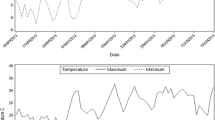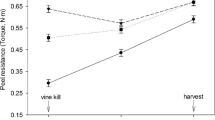Abstract
Sixteen vine kill programs were tested on Bintje and Ciklamen potato cultivars grown for early potato production over a three year period near Paterson, Washington. Mechanical (flail chopping, flail chopping and undercutting), chemical (glufosinate, diquat, sulfuric acid, carfentrazone, pyraflufen-ethyl), and physical (flaming) vine kill methods, and sequential combinations of the three were effective in killing rapidly growing potato vines of Bintje and Ciklamen. Rolling and crimping did not kill vines as completely and more vine regrowth occurred than with most other methods tested. Tuber skinning injury was greatly reduced when harvesting at 4 weeks after initial vine kill than at 2 weeks. None of the vine kill programs were able to hasten skin set enough to allow tubers to be harvested at 2 weeks after initial vine kill without significant tuber skinning injury. Glufosinate treatments that were applied several days earlier than other initial vine kill treatments tended to average less skinning injury at the early harvest possibly due to more time elapsing between initial vine kill and harvest. Total tuber yield and size distribution were similar among most vine kill treatments, with the exception of the earlier applied glufosinate treatments, which tended to reduce total yield, but still yielded a similar mass of desired 25 to 35 mm diameter tubers. Tubers from vine-killed plots tended to average greater N, P, K, Fe, and Ca content than tubers from non-killed control plots of both cultivars. Tuber ascorbate levels were also greater in non-killed controls, whereas total phenolic content tended to be greatest in earlier-applied glufosinate treatments. Nonchemical vine kill methods, chemical vine kill methods, and combinations of the two were identified that killed vines well, had low skinning injury at the 4 week harvest, and yielded similar amounts of 25 to 35 mm diameter early potato tubers.
Resumen
Se probaron 16 programas de muerte del follaje en las variedades de papa Bintje y Ciklamen cultivadas para producción temprana de papa en un período de tres años cerca de Paterson, Washington. Los métodos mecánicos de secado (picado y picado con corte al suelo), químico (glufosinato, diquat, ácido sulfúrico, carfentrazone, etil-piraflufeno), y físico (con flama) y combinaciones secuenciadas de los tres, fueron efectivos en la muerte rápidamente de los follajes de papa en crecimiento de Bintje y Ciklamen. El enrollado y el engastado no mataron los follajes completamente, y se presentó más rebrote de follaje que con la mayoría de los otros métodos probados. El daño por descascareo del tubérculo se redujo grandemente cuando se cosechó cuatro semanas después del secado que con dos semanas. Ninguno de los programas del secado del follaje fue capaz de acelerar el embarnecimiento de la piel lo suficiente para permitir a los tubérculos que fueran cosechados dos semanas después del desecado inicial sin daño significativo de descascareo. Los tratamientos con glufosinato que fueron aplicados varios días más temprano que otros tratamientos iniciales de eliminación del follaje, tendieron a promediar menos daño de descascareo en la cosecha temprana, posiblemente debido al mayor tiempo que pasó entre la eliminación inicial del follaje y la cosecha. El rendimiento total de tubérculo y la distribución de tamaños fueron similares entre la mayoría de los tratamientos de desecado, con excepción de los tratamientos aplicados temprano de glufosinato, los cuales tuvieron la tendencia de reducir el rendimiento total, pero aun así rindieron una masa similar de tubérculos deseados de 25 a 35 mm de diámetro. Los tubérculos de los lotes desecados tendieron a promediar un contenido mayor de N, P, K, Fe, y Ca que los tubérculos de los lotes testigos no desecados de ambas variedades. Los niveles de ascorbato en los tubérculos también fueron mayores en los testigos sin eliminación del follaje, mientras que el contenido de fenoles totales tuvo la tendencia de ser mayor en los tratamientos de aplicación temprana de glufosinato. Los métodos no químicos de eliminación de follaje, los químicos, y las combinaciones de los dos, se les identificó como que eliminaron bien al follaje, ocasionaron bajo daño en la piel, a las cuatro semanas a la cosecha, y rindieron cantidades similares de 25 a 35 mm de diámetro de tubérculos tempranos de papa.


Similar content being viewed by others
References
Ballingall, M.. 2012. Haulm destruction in potato crops. Scottish Agricultural College. Technical Note, TN644. 4 pps.
Benzie, I.F., and J.J. Strain. 1996. The ferric reducting ability of plasma (FRAP) as a measure of “antioxidant power”: the FRAP assay. Analytical Biochemistry 239: 70–76.
Bowen, S.A., A.Y. Muir, and C.T. Dewar. 1996. Investigations into skin strength in potatoes: factors affecting skin adhesion strength. Potato Research 39: 313–321.
Buono, V., A. Paradiso, F. Serio, M. Gonnella, L. DeGara, and P. Santamaria. 2009. Tuber quality and nutritional components of “early” potato subjected to chemical haulm desiccation. Journal of Food and Composition Analysis 22: 556–562.
Carlson, H.L., and D. Kirby. 2005. Development of Cultural Techniques for Production of Baby Potatoes. University of California Intermountain Research and Extension Center Research Progress Report 110: 1–7.
Davis, A.S. 2010. Cover-crop roller-crimper contributes to weed management in no-till soybean. Weed Science 58: 300–309.
Dixon, R., and N. Paiva. 1995. Stress-Induced Phenylpropanoid Metabolism. The Plant Cell 7: 1085–1097.
Gonnella, M., O. Ayala, A. Paradiso, V. Buono, L. DeGara, P. Sanamaria, and F. Serio. 2009. Yield and quality of early potato cultivars in relation to the use of glufosinate-ammonium as desiccant. Journal of the Science of Food and Agriculture 89: 855–860.
Haderlie, L.C., J.L. Halderson, D.L. Corsini, and R.B. Dwelle. 1989. Potato vine killing. Bull. No. 759: Idaho Co-op Ext 4 pp.
Halderson, J.L., L.C. Haderlie, and D.L. Corsini. 1985. Potato Vine Kill: Pulling, Chemical, Killing, and Rolling Effects on Yield and Quality of Russet Burbank. American Potato Journal 62: 281–288.
Isaac, R.A., and W.C. Johnson. 1998. Elemental determination by inductively coupled plasma atomic emission spectrometry. In Handbook and reference methods for plant analysis, ed. Y.P. Kalra, 165–170. New York: CRC Press.
Ivany, J.A., and J.B. Sanderson. 2001. Response of potato (Solanum tuberosum) cultivars to glufosinate-ammonium and diquat used as desiccants. Weed Technology 15: 505–510.
Kempenaar, C., and P.C. Struik. 2007. The Canon of Potato Science: Haulm Killing. Potato Research 50: 341–345.
Knowles, N.R. and E.S. Plissey. 2008. “Maintaining tuber health during harvest, storage, and post-storage handling.” In: Potato Health Management. Ed. Johnson, D.A. pages 79–99.
Lulai, E.C. 2002. The Roles of Phellem (Skin) Tensile-related Fractures and Phellogen Shear-related Fractures in Susceptibility to Tuber-skinning Injury and Skin-set Development. American Journal of Potato Research 79: 241–248.
Lulai, E.C., and T.P. Freeman. 2001. The Importance of Phellogen Cells and their Structural Characteristics in Susceptibility and Resistance to Excoriation in Immature and Mature Potato Tuber (Solanum tuberosum L.) Periderm. Annals of Botany 88: 555–561.
Navarre, D.A., R.S. Payyavula, R. Shakya, and N.R. Knowles. 2013. Changes in potato phenylpropanoid metabolism during tuber development. Plant Physiology and Biochemistry 65: 89–101.
Parr, A.J., and G.P. Bolwell. 2000. Phenols in the plant and in man. The potential for possible nutritional enhancement of the diet by modifying the phenols content or profile. Journal of the Science of Food and Agriculture 80: 985–1012.
Pavlista, A.D. 2001. UCC-C4243 desiccation of potato vines. 2001. HortTechnology 11: 86–89.
Pavlista, A.D. 2002. Skin Set Evaluation by Skin Shear Measurements. American Journal of Potato Research 79: 301–307.
Payyavula, R.S., D.A. Navarre, J.K. Kuhl, and A. Pantoja. 2013. Developmental effects on phenolic, flavonol, anthocyanin, and carotenoid metabolites and gene expression in potatoes. Journal of Agricultural and Food Chemistry 61: 7357–7365.
Prairie Agricultural Machinery Institute (PAMI). 2003. Comparison of alternative mechanical & chemical top-kill methods for seed potatoes. ISSN 1188–4770. Publication No. 764, 4 pps.
Renner, K.A. 1991. Chemical Vine Desiccation of Two Potato Cultivars. American Potato Journal 68: 479–491.
Sabba, R.P., A.J. Bussan, B.A. Michaelis, R. Hughes, M.J. Drilias, and M.T. Glynn. 2007. Effect of Planting and Vine-kill Timing on Sugars, Specific Gravity and Skin Set in Processing Potato Cultivars. American Journal of Potato Research 84: 205–215.
Sanderson, J.B., J.A. Ivany, and R.P. White. 1984. Effect of time of desiccation on seed potato yield and size distribution. American Potato Journal 61: 691–696.
Singleton, V.L., and J.A. Rossi. 1965. Colorimetry of total phenolics with phosphomolybdic-phosphotungstic acid reagents. American Journal Enology and Viticulture. 16: 144–158.
Waterer, D. 2007. Vine desiccation characteristics and influence of time and method of top kill on yields and quality of four cultivars of potato (Solanum tuberosum L.). Canadian Journal of Plant Science 87: 129–135.
Zotarelli, L. S. Sargent, P. Dittmar, and M. Makani. 2016. Potato vine killing or desiccation. Institute of Food and Agricultural Sciences (IFAS), University of Florida Extension Service. Publication HS925. 4 pps.
Acknowledgements
We thank AgriNorthwest farm for supplying land, irrigation water, and electricity for the Paterson, WA research farm. We thank Potandon Produce and J.R. Simplot Co.for providing seed tubers of Ciklamen and Bintje used in these studies and the Washington State Potato Commission for partial funding of the research. We also thank Encarnacion Rivera, Treva Anderson, Bill Boge, Marc Seymour, and Joanne Holden for their excellent technical support.
Author information
Authors and Affiliations
Corresponding author
Rights and permissions
About this article
Cite this article
Boydston, R.A., Navarre, D.A., Collins, H.P. et al. The Effect of Vine Kill Method on Vine Kill, Tuber Skinning Injury, Tuber Yield and Size Distribution, and Tuber Nutrients and Phytonutrients in Two Potato Cultivars Grown for Early Potato Production. Am. J. Potato Res. 95, 54–70 (2018). https://doi.org/10.1007/s12230-017-9614-0
Published:
Issue Date:
DOI: https://doi.org/10.1007/s12230-017-9614-0




